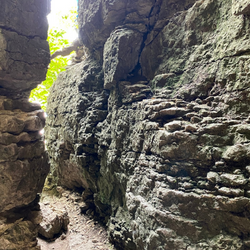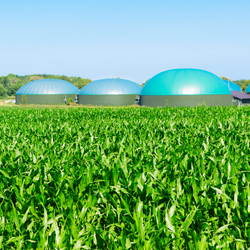Diving Into Manure Management
posted
on Friday, October 14, 2022
in
Water and Land News
The Iowa Department of Natural Resources (DNR) released proposed revisions to rules regulating animal feeding operations and livestock manure in August 2021. IEC reviewed the draft rules in depth to prepare formal comments in response and found that DNR has not proposed to do enough to protect Iowa’s surface water or groundwater. This can affect how Iowans use our water all across the state – from drinking to fishing to recreating.
The list of issues IEC identified that need further action includes:
 Karst terrain: Karst is soluble bedrock like limestone that can have sinkholes and caves. It is vulnerable to manure leaks that lead to water pollution of groundwater and surface water, including drinking water sources. IEC petitioned DNR to increase vertical separation between manure structures and karst from 5 feet to 25 feet. DNR’s proposed rules now require a 15-foot separation, including five feet of non-porous soil/rock or a two-foot compacted clay liner. While this is an improvement over the existing rule, statute allows the DNR be more protective. DNR is choosing not to do so.
Karst terrain: Karst is soluble bedrock like limestone that can have sinkholes and caves. It is vulnerable to manure leaks that lead to water pollution of groundwater and surface water, including drinking water sources. IEC petitioned DNR to increase vertical separation between manure structures and karst from 5 feet to 25 feet. DNR’s proposed rules now require a 15-foot separation, including five feet of non-porous soil/rock or a two-foot compacted clay liner. While this is an improvement over the existing rule, statute allows the DNR be more protective. DNR is choosing not to do so. - Over-application of manure: Manure is a major source of nitrate pollution to groundwater and streams. Existing rules allow manure application at rates higher than crops can use and do not account for other fertilizers. DNR did not propose to fix this. Iowa’s Nutrient Reduction Strategy – which the legislature adopted as official state policy – calls for manure application at the right rate in every scenario to meet water quality goals. Reducing nutrients to the rate that crops need would save $32 million per year in fertilizer costs. It also means Iowans pay less money to remove the nitrate downstream to make water safe for consumption.
- Evaluating pollution impacts: Existing rules allow the DNR director to evaluate a facility and impose special permit conditions or prohibit the facility if it would cause water pollution. IEC petitioned to strengthen the rules to require DNR evaluations of high-risk sites, but DNR has proposed to delete this option entirely. Such a rule would allow DNR to stop proposals that don’t make sense, like Supreme Beef. Removing this rule will continue to allow CAFOs that threaten drinking water sources.
.png) LLC Loophole: CAFO owners may create separate businesses for adjacent CAFOs to avoid being regulated as a single large facility. Under existing rules, both confinements and open lots were subject to the same evaluation of “common ownership.” The proposed rules limit the common ownership test to confinements. They also do not require submitting ownership documentation to DNR, allowing joint facilities to operate just below the thresholds for permitting and manure management planning.
LLC Loophole: CAFO owners may create separate businesses for adjacent CAFOs to avoid being regulated as a single large facility. Under existing rules, both confinements and open lots were subject to the same evaluation of “common ownership.” The proposed rules limit the common ownership test to confinements. They also do not require submitting ownership documentation to DNR, allowing joint facilities to operate just below the thresholds for permitting and manure management planning. - Paper plans: The proposed rules let large facilities submit Manure Management Plans on paper rather than electronically. These plans define how much manure can be applied on individual fields. With paper plans, DNR must manually compare new plans to check for overlap with other plans. This wasteful, inefficient approach evades public scrutiny and makes it nearly impossible to enforce the plans. IEC requested the plans be submitted electronically with geospatial information so DNR can electronically review and ensure compliance.
 Anaerobic digesters: DNR proposed to expand the definition of anaerobic manure digesters, but not the regulations accompanying them. This expansion without addressing regulation creates risks to air quality and water quality from leaks in the digester systems. Other states that have authorized digesters also required permitting and oversight that matches the new type of manure management.
Anaerobic digesters: DNR proposed to expand the definition of anaerobic manure digesters, but not the regulations accompanying them. This expansion without addressing regulation creates risks to air quality and water quality from leaks in the digester systems. Other states that have authorized digesters also required permitting and oversight that matches the new type of manure management. - Monitoring: IEC had petitioned DNR for monitoring of earthen basins holding manure, which can leak nitrate and other contaminants into groundwater. Rather than require sufficient monitoring, the proposed rules reduce the frequency and scope of water quality monitoring for manure storage and treatment systems. The proposed rules make it less likely that a leak will be identified before manure enters a river, stream, or groundwater. DNR should require the monitoring we sought in the petition.
The proposed rules would make a few positive changes. For example, the proposed rules would adopt a floodplain map, which will restrict future CAFO development. IEC petitioned for adoption of a floodplain map because the legislature directed DNR to do so in 2002. IEC hopes DNR will follow through in adopting the map.
State law adopted by the Iowa Legislature limits DNR’s authority to adopt adequate regulation on other significant issues for water quality. For example, DNR cannot prohibit all construction on karst terrain, because state law allows earthen manure basins above karst terrain. State law also sets separation distances between CAFOs and residences, public spaces, and waterbodies. The CAFO construction limitations in the 100-year floodplain only apply to “major water sources” rather than any floodplain. State law only requires manure management planning for large facilities (e.g., 1,000 beef cattle, 2,500 hogs) even though facilities slightly under that threshold still produce enormous volumes of manure.
To fully protect water quality, Iowa cannot exempt major sources of pollution from regulation. Until the legislature changes the law, DNR should use its existing authority to adopt stronger rules.
Read the comments IEC and partners submitted to DNR in October 2022.